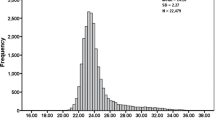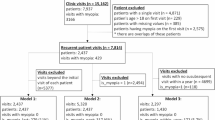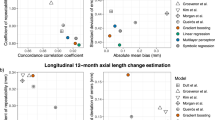Abstract
Purpose
To investigate the possible risk factors associated with lenticular progressive myopia and to compare the differences between patients with lenticular progressive myopias and senile cataracts.
Methods
We retrospectively reviewed cases that had been diagnosed as lenticular progressive myopia with a discrete nuclear sclerotic cataract and progressive myopic changes in one hospital from January 1998 to February 2003. A total of 47 eyes of 35 patients were enrolled in this study. In all, 32 eyes of 29 cases of common senile cataract receiving cataract extraction surgery during the study period were randomly chosen (every four cases in time sequence within a 2-month period by two ophthalmologists' clinic in 2002) as the control group. We compared the preoperative refraction status, keratometry (K-values) and axial lengths between these two groups. The possible ocular or systemic associating diseases were also investigated in the study group.
Results
In the lenticular progressive myopia group, the mean age at surgery (52.9±9.2 years) is younger than that in the senile cataract group (68.1±7.3 years). The mean axial length in the study group (25.68±1.93 mm) is statistically significant longer than that in the control group (22.97±0.83 mm) (P<0.0001). Besides, patients with lenticular progressive myopia had significantly lower mean K-values (43.25±1.42 diopters) than patients with senile cataracts (44.25±1.28 diopters) (P<0.01). There were no other ocular or systemic diseases closely associated with lenticular progressive myopia.
Conclusions
Patients with nuclear cataract combined with lenticular progressive myopia have longer axial length than patients with senile cataract. The longer axial length may be one of the important risk factors predisposing to lenticular progressive myopia.
Similar content being viewed by others
Log in or create a free account to read this content
Gain free access to this article, as well as selected content from this journal and more on nature.com
or
References
Cordes FC . Cataract Types. American Academy of Ophthalmology and Otolaryngology, 1946, cited from ref. 2.
Levin ML . Opalescent nuclear cataract. J Cataract Refract Surg 1989; 15: 576–579.
Kaufman BJ, Sugar J . Discrete nuclear sclerosis in young patients with myopia. Arch Ophthalmol 1996; 114: 1178–1180.
Brown NAP, Hill AR . Cataract: the relation between myopia and cataract morphology. Br J Ophthalmol 1987; 71: 405–414.
Curtin BJ (ed). The development of refraction. The Myopias: Basic Science and Clinical Management. Harper & Row Publishers Inc., New York, 1985, pp 33–36.
O'Donnell Jr FE, Maumenee AE . Unexplained' visual loss in axial myopia: cases caused by mild nuclear sclerotic cataract. Ophthalmic Surg 1980; 11: 99–101.
De Natale R, Romeo G, Fama F, Scullica L . Human lens transparence in high-myopic subjects. Ophthalmologica 1992; 205: 7–9.
Chen SN, Lin KK, Chao AN, Kuo YH, Ho JD . Nuclear sclerotic cataract in young patients in Taiwan. J Cataract Refract Surg 2003; 29: 983–988.
Tsai SY, Hsu WM, Cheng CY, Liu JH, Chou P . Epidemiologic study of age-related cataracts among an elderly Chinese population in Shih-Pai, Taiwan. Ophthalmology 2003; 110: 1089–1095.
Palmquist BM, Philipson B, Barr PO . Nuclear cataract and myopia during hyperbaric oxygen therapy. Br J Ophthalmol 1984; 68: 113–117.
Cunning RG, Mitchell P, Smith W . Diet and cataract. Ophthalmology 2000; 107: 450–456.
Michael R, Brismar H . Lens growth and protein density in the rat lens after in vivo exposure to ultraviolet radiation. Invest Ophthalmol Vis Sci 2001; 42: 402–408.
Weale R . A note on a possible relation between refraction and a disposition for senile nuclear cataract. Br J Ophthalmol 1980; 64: 311–314.
Fisher RF . Senile cataract: a comparative study between lens fibres stress and cuneiform opacity formation. Trans Ophthalmol Soc UK 1970; 90: 93–109.
Acknowledgements
This study was supported by the research grant TCRD 93-08 from Buddhist Tzu Chi Medical Center.
Author information
Authors and Affiliations
Corresponding author
Rights and permissions
About this article
Cite this article
Lin, HY., Chang, CW., Wang, HZ. et al. Relation between the axial length and lenticular progressive myopia. Eye 19, 899–905 (2005). https://doi.org/10.1038/sj.eye.6701690
Received:
Accepted:
Published:
Issue date:
DOI: https://doi.org/10.1038/sj.eye.6701690



